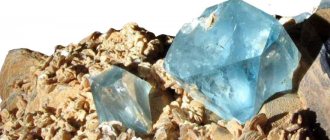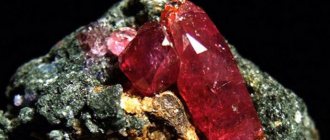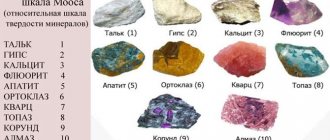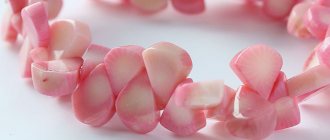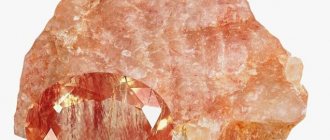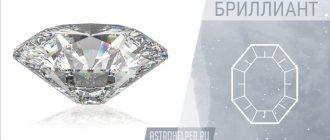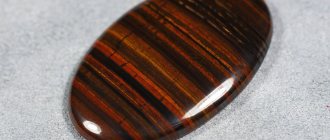For many hundreds of years, stones have attracted human attention. They fascinate with their unique beauty, which has absorbed strength from the very heart of the Earth. Unraveling the mysterious properties of stones, people began to endow them with magical properties, using them as talismans and amulets.
Each mineral is unique and inimitable, each carries a mystery and mystery. The magic stone aragonite is a bright representative of the scattering of gems.
Story. Origin
In Spain there is a legend about the origin of the mineral.
Its popular name is “stone of tears.” According to legend, the tears of a girl from the Spanish city of Molina de Aragon, whose parents separated her from her lover and married her to an unloved but rich man, turned into such pebbles. Scientists first paid attention to aragonite at the end of the 18th century and gave it a name consonant with the name of the Spanish region of Aragon, where extensive deposits of this mineral were discovered. There they formed due to a significant drop in sea level approximately 230 million years ago . Large-scale deposition of gypsum and salts occurred, which subsequently led to the formation of aragonite.
Aragonite is always a young gemstone, since it lasts no more than a hundred million years, and then turns into an ordinary calcite.
This mineral is found in different countries where there are karst caves and basalt voids. It is also formed at the bottom of oceans and rivers, deposited in geysers and other sources in which the water is saturated with carbonate compounds. Thus, on the surface of the water in Karlovy Vary and Baden-Baden there is a calcite film, which turns any object immersed in water for a few minutes into a mother-of-pearl jewel.
“Aragonite roses” are the symbol of Karlovy Vary. Parchment roses and vases are dipped into a thermal spring, and after some time they become pearlescent.
Manufacture maintenance rules
Proper maintenance of your jewelry can help keep your gemstones sparkling for a long time.
In most cases, they do not prefer dazzling sunlight: they become pale. For this reason, it is necessary to store the product from it in a dark room, separately from other precious stones. The perfect type is a casket or box filled with soft fabric from the inside. The place of detention should be at a far distance from heat. There is no need to overlook the fact that high temperatures are detrimental to aragonite.
He is afraid of unconscious defects, for this reason you should remove it properly before going to the gym if you want to do any work related to physical activity.
Physicochemical characteristics
Aragonite is a polymorph of calcium carbonate. Its chemical formula is similar to that of calcite, but the crystal lattices of these minerals are different.
The exact composition of aragonite is determined by impurities. They create a variety of shades. For example, zinc creates a red-brown-violet palette, and the dominance of iron provides a yellow color to the stone.
- The chemical formula is CaCO3 .
- Color - colorless, white, yellowish, gray, reddish, rarely - blue and blue-green.
- The shine is glassy.
- Transparency - transparent, translucent.
- Hardness - 3,5–4.
- Density - 2.93 g / cm3 .
Aragonite is fragile. This was noted by the stone cutters. To improve its aesthetic conditions, they heated it, but this turned the stone into powder, since the crystal lattice was destroyed by the increase in volume. When heated above 400 °C, aragonite quickly turns into calcite, and on fire it crumbles into calcite powder.
In nature, aragonite over 10–100 million years .
Aragonite is part of the mother-of-pearl layer of sea shells and the exoskeleton of corals. The origin of this mineral is recognized by its shape:
- Round and other smooth specimens are obtained from the sea.
- Hexagonal prisms, spear-shaped crystals, “flowers”, “twigs” are formed in caves in the form of deposits of carbonate dissolved in water. They are known as stalactites.
Color varieties
The color of aragonite stone depends on the chemical additives in its composition and its natural shape.
The variety of gemstone shapes is amazing. The rounded small nuggets are referred to as "cave pearls." Stones of unusual configurations, similar to plants, were called “iron flowers.” Needle-shaped crystals are found in nature. In appearance, helictites are similar to corals.
In the form of a delicate mother-of-pearl coating, it is found on shell valves and enters into the structure of the pearl.
Place of Birth
In nature, aragonite is much less common than calcite, which is similar in composition.
The main deposits of this mineral are concentrated on the ocean floor. On land they are found mainly in karst caves. Large deposits are located in Europe. High-quality stones are mined in Spain, Sicily, and also in Africa (Morocco). Mining is also carried out in France, Germany, the Czech Republic, Austria, Mexico, the USA, Japan, China, Turkmenistan, and Kyrgyzstan.
Russian deposits are concentrated in the Southern Urals and Taimyr.
Crystallographic characteristics
Syngony. Rhombic (pseudo-hexagonal).
Symmetry class. Rhombic bipyramidal mmm. V. With. 3L23PC. Etc. gr. Pmcn(D162h). a0 = 4.94; b0 = 7.94; с0 = 5.72. Axle ratio. 0.622: 1: 0.720.
Crystal structure
The structure of aragonite is denser than the structure of calcite. As in the calcite lattice, in the aragonite lattice each CO3 ion is surrounded by six calcium ions.
Main shapes: Main shapes: prism {110}, pinacoids {010}f and {001}. The latter is covered with strokes parallel to the a-axis. The following forms are often found: prism {011}, sharpening the crystals like a chisel, dipyramid {111}, in some cases very sharp dipyramids in combination with prisms, as a result of which the crystals take a spear-shaped shape
Varieties. Color
The variety of shapes and colors of aragonite is impressive.
Main types
Aragonite crystals come in a variety of shapes:
- Helictites. Found in karst caves. They look like coral branches, form complex branched aggregates, the crystals of which grow from the center in different directions. The color ranges from milky white to black.
- Needle-shaped crystals. They look like long needles. Absolutely colorless, fragile.
- Pisolites. Their shape is a ball, the diameter of which is slightly larger than 2 mm . Used in jewelry. Also known by the names: cave pearls, marble onyx, caviar stone .
- “Iron flowers” (“metal flowers”) - layers of the mineral are intertwined into “inflorescences”. This variety is prized by collectors.
- "White Sea flyers" . They are shaped like a star with four rays.
- Oolites are egg-shaped pebbles that are formed from aragonite intergrowths in areas of changeable currents and surf.
- Conchite is a fibrous mineral that gives the shells of marine mollusks their pearlescent luster.
A thin layer of aragonite-conchite and organic matter is responsible for the nacre of sea pearls and shells.
Color variety
White aragonite is most often found in nature. But there are also stones of other colors. The color depends on the chemical impurities in their composition.
Aragonite colors:
- White - in its pure form, such specimens are mainly mined in Mexico.
- Orange - found in the form of pisolites and oolites.
- Brown-red color is due to the presence of zinc.
- Brown-violet - the stone has a high lead content.
- Blue is zeirentite, one of the most beautiful and most valuable varieties.
- Blue-green - samples with this color and prism-shaped shape are called iglites.
Read also : Ammolite - a stone of rainbow tints that brings good luck
Types of aragonite
Stone is distinguished by several characteristics: color, transparency and the shape of natural formations. In terms of shade, there are completely transparent or white aragonites, yellowish-orange colors, orange-brown and brown-violet stones. You can also find greenish, turquoise and gray shades of the gem.
The stone is almost always transparent, sometimes a little cloudy, but always translucent, giving a slight glare in the sun and a slightly sparkling shine. The internal structure is always non-smooth - with reliefs and layers, imperfect cleavage, conchoidal in fracture.
Geologists and mineralologists distinguish many types of stone based on the type of formation. It is enough to know that they are found in form:
- needle-shaped formations similar to cave stalactites or plants in frost; these also include the so-called iron flowers;
- cave pearls are rounded small clumps found in rock strata, otherwise called pisolite or oolite;
- branched thickened growths resembling corals – helictites.
Also distinguished are tarnovites - hexagonal crystals of brown-violet color with lead impurities, and nicholsonites - round stones of red-brown and violet color with inclusions that contain zinc.
Application
Although aragonite is a brittle mineral, this has not become an obstacle to its use:
Jewelers value this gemstone for its rich color palette and interesting shapes. Particularly beautiful are the complex clusters of crystals that look like buds - they are used to make beautiful rings, pendants, and earrings. Moreover, in this case the crystals are not processed. White stones are often ground into the shape of pearls; they look no different from real ones and are perfect for making beads. For men, silver or platinum rings with a darker colored mineral are made.
The frame of aragonite jewelry is made of precious metals: silver, gold, platinum.
Stone cutters make vases, boxes, figurines, photo frames, desk writing instruments, and various figurines (pyramids, balls, etc.) from aragonite.
Collectors usually purchase the mineral in its natural form. More often in collections you can find stones formed by sintering, with intricate intergrowths of crystals. Valuable collection material are “White Sea fliers” and “iron flowers”. Each specimen of aragonite is unique due to the unique shape and color, and the price of the mineral, even from distant places, is not very high.
Jewelry with mineral
Aragonite is a precious jewelry mineral. Luxurious jewelry with stones serve as proof of the excellent taste and respectability of their owner. Blue crystals resemble turquoise, and white ones are even ground into the shape of pearls. Various jewelry is made from the gem - pendants, beads, rosaries, earrings, brooches and rings are encrusted.
You can buy jewelry in a jewelry salon or store specializing in natural stone products, as well as on the Internet. The price of the product depends on the quality and deposit of the mineral and the material of the frame. Approximate prices for jewelry:
- Ordinary aragonite earrings – from 200 rubles;
- White aragonite beads (Mexico), 48 cm – from 2900 rubles;
- Silver ring with aragonite – 790-2000 rubles;
- Silver ring with a stone weighing 20 carats, Germany – 18,800-22,900 rubles.
The use of the gem is not limited to jewelry. Boxes, vases, figurines, and various souvenirs are traditionally made from it.
In addition, the gem serves as an interesting collection material. “Iron flowers” and “White Sea flyers” are especially valued.
Important! Don't buy jewelry that has already been used. After all, a stone can carry the negative energy of its former owner.
Medicinal properties
Aragonite is called the stone of healing. It is believed that this gem will help in the treatment of diseases if it is placed in the room of a sick person or if a sick person carries the stone with him.
It should be noted that the mineral must be used without abandoning the treatment prescribed by the doctor.
Lithotherapists note the following healing properties of aragonite:
- Calms nervous people, relieves aggression, anger, anxiety, insomnia, depression.
- Helps in the treatment of skin diseases: nervous, infectious, allergic. In this case, lotions made from wet aragonite powder are used.
- Strengthens nails and hair.
- Prevents muscle spasms and cramps.
- Helps treat joints and spine.
- Reduces fever, heat, internal inflammation.
- Helps to recover faster from illness.
- Helps strengthen the immune system.
- Facilitates the manifestations of menopause, reduces senile dementia.
- Helps treat diseases of the reproductive organs.
The healing properties of aragonite are due to the fact that it contains a lot of calcium, which is necessary for humans.
To get healthy, you need:
- apply the mineral to certain points on the body;
- wear aragonite jewelry that comes into contact with the skin (beads, etc.);
- drink aragonite water and make lotions with it.
To make water similar to the healing water of Karlovy Vary and Baden-Baden, you need to pass it through aragonite chips.
Proper storage
An aragonite product will last a long time if you adhere to the following rules:
- The jewelry should be stored in a box with soft walls;
- Aragonite should not be allowed to come into contact with perfumes, cosmetics, or chemicals;
- Remove jewelry before going to bed, going to the bathhouse, or swimming pool;
- If dark spots appear, wipe with a soft cloth.
Magic properties
Esotericists have found that aragonite enhances the effect of meditation and prayer, as it brings the various energies of the human body to balance. Its crystals help to find harmony and peace.
Aragonite talismans help preserve the family, strengthen family unity and harmony. For this, it will be enough if someone from the family wears a talisman in the form of jewelry with this gem. The stone can improve relationships only between loving spouses, but it cannot return to the family someone who is burdened by marital ties.
Any aragonite amulet has meaning for a person as a talisman against anything that could destroy family life. If you wear such an amulet, it will ward off outside hobbies, addiction to drinking, and gambling.
Esotericists do not advise single people to wear aragonite jewelry, lest their life change for the worse.
It is believed that the magical properties of aragonite help the owner in many ways:
- They increase a person’s self-confidence, bestow wisdom, and suggest the right decisions in difficult life situations.
- They help teenagers and middle-aged people survive age-related difficulties.
An aragonite talisman will help the owner maintain a good memory and a bright mind until old age.
If you place a figurine or druse of crystals in a prominent place in your home, aragonite will attract financial well-being. An aragonite figurine or pebble in the kitchen (but not near the stove or radiator!) will help you run your household better.
Amulets and talismans
The keeper of the family hearth helps to maintain peace and tranquility in relationships. Aragonite amulets are suitable for those couples who are often stressed and have difficulty resolving conflicts. The talisman will protect the owner from drunkenness, binge drinking and wastefulness, which always reflects poorly on the family.
Astrologers recommend treating the stone carefully and with care if it serves as a talisman for the home and stands, for example, on a shelf in the hallway or hanging in the bedroom. If the stone has become dull for no reason or has cracked, this indicates that the mineral has taken an energetic blow and needs to be either replaced or cleaned.
Aragonites are cleaned with running water, the amulet is placed under running water for 10-15 minutes (it is better if it is spring water), then dried and wiped with a soft cloth.
Who is suitable according to their zodiac sign?
Aragonite is one of the few stones that, according to astrologers, is suitable for all zodiac signs. The only condition is that the person be married, and whether the marriage is officially registered does not matter.
This mineral is an effective amulet and talisman that protects the family hearth, bringing happiness, love, and prosperity.
Of great importance for a person is the ability of aragonite to fill the house with positive energy, to keep peace and tranquility in it.
Despite the fact that the magical properties of aragonite are suitable for all zodiac signs, some astrologers believe that according to the horoscope, wearing this stone is especially useful for Cancer, Pisces and Capricorn . It will significantly improve their life and protect them from many troubles.
Read also : Tektite earthly or cosmic stone ?
Compatibility with other stones
Aragonite is protected by two elements - Water and Earth, so it is ideally combined with minerals of these elements in amulets and talismans.
Excellent compatibility in jewelry with:
- turquoise;
- carnelian;
- coral.
The proximity to elite sapphires, emerald, and alexandrite is also favorable. In general, aragonite can be combined with any gems, since it does not conflict and is “friendly” with almost all stones. But when it comes to decorations, it is better to take into account their color combination. For example, it is recommended to combine white specimens with blue ones, and reddish ones with black ones.
Extraordinary Features
Aragonite is a constant companion of healers and miracle workers, promoting the presence of spiritualism procedures, communication with unearthly forces, since it is believed that it is ideally grounded and focused on activity. Can increase the process of prayer or magic spells.
- These crystals give humility, true calm and inner stability, promote reflection, and balance various activities in the human body.
- Aragonite is the true holder of the marital hearth, spreading its own magic only for the family. It is advisable to leave your figurines or fakes at home to attract wealth, convenience and good luck to the family.
- Such a solid body will help spouses maintain joint emotions, attract attraction in refreshing connections, and destroy differences and hostile thoughts.
- Accordingly, it can help open a connection between the older and younger generations, it is combined in the absence of family disputes, restoring peace and equanimity.
- Helps increase financial family wealth, free from need.
- Frees careless owners from apathy, helping to implement the household, filling the house with warmth and comfort.
- Helps to perceive moral and family virtues.
- These amulets are ready to prevent alcoholism, betrayal and other shortcomings.
How to wear and care
Aragonite is a fragile stone, so you need to wear and care for jewelry carefully and carefully. This will help preserve the radiance and shine of the mineral for a long time.
- Jewelry should be removed before homework, going to the beach, swimming pool, bathhouse, sauna, gym, before applying makeup (put on when cosmetics have already been absorbed or dried).
- Aragonite becomes dull in bright sunlight, so you should not wear jewelry made of stone in hot weather.
- Do not place aragonite figurines near the fireplace, radiators, heating devices, or kitchen stove - under the influence of high temperature, the mineral can crumble or turn into calcite.
- It is better to store aragonite in an opaque, tightly closed box, soft from the inside, separately from other stones.
- Dust from the stone should be wiped off with dry flannel or soft suede. If the contamination is severe, clean with soapy water and a cloth, and then rinse well with clean water.
- It is better to clean the frame with a cotton swab and a special cleaning agent, making sure that it does not get on the mineral.
How to distinguish from a fake
Although the price of aragonite is not very high, there are fakes made of plastic or glass. You can distinguish a natural stone from a fake in the following ways.
- Warmth. Natural minerals are always cool. They do not heat up in your hands for a long time, unlike plastic or glass.
- By weight. Natural stone is heavier than glass and plastic of the same size.
- Photoluminescence. Place under ultraviolet light or expose to the sun. The natural gem will glow orange-red.
The best way to avoid buying a fake is to purchase aragonite figurines or jewelry from reliable sellers who have the appropriate documents and certificates.
Price
Aragonite is a semi-precious stone. This circumstance and the widespread distribution of the mineral due to the ease of extraction determined the availability of prices for it (rubles):
- White tumbling (2–3 cm) — 240–290.
- Crystal intergrowths (3–4 cm) — 380–650.
- Egg (3 x 4 cm) - 820.
- Ball (4.8–6.3 cm) - 1700–3560.
- Crystals (7.5 x 6 x 5.5 cm) - 2550–2800.
- Picturesque aragonite sagging (for collection) - 310–430.
- Polished plate (100 g) - approx. 620.
The cost of aragonite jewelry depends not only on the quality of the stone, but also on the material of the frame, the work of the craftsman and is in the range of 2,500–31,000 rubles .
It is better not to buy jewelry that has already been used, as the stone may retain the negative energy of the former owner.
Read also : Andalusite - a stone that helps to understand the essence of people
